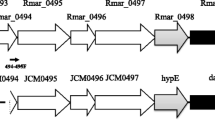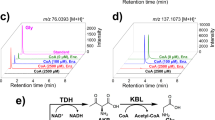Abstract
A new enzyme (isobutylidenediurea amidinohydrolase) catalyzing the hydrolysis of isobutylidenediurea (a condensation product of urea and isobutyraldehyde widely used as a slow-release nitrogeneous fertilizer) was characterized from a strain of Rhodococcus erythropolis. The enzyme was purified 1250-fold to apparent homogeneity and shown to hydrolyze the fertilizer to urea and isobutyraldehyde at a molar ratio of 2 : 1. No activity was observed with ureido- or other structurally related compounds. Its molecular mass was determined by native polyacrylamide gelelectrophoresis and matrix-assisted laser desorption/ionisation time-of-flight mass spectrometry to be 15 kDa (±2 kDa) and 16.4 kDa, respectively. Growth of the bacterium in the presence of isobutylidenediurea led to an increased expression of the constitutively synthetized enzyme.
Similar content being viewed by others
References
Alexander A &Helm H-U (1990) Ureaform as a slow-release fertilizer: a review. Z. Pflanzenernähr. Bodenk. 153: 249–255
Bulygina SM,Gritsenko LP,Sokolovskaya IE &Sarbaev AN (1987) Hydroxymethyl derivatives of urea and formaldehyde: conditions of their formation. J. Appl. Chem. USSR 60: 419-421
Chiang CT (1970a) Decomposition and nitrogen transformation of slow-acting nitrogenous fertilizers in soils. Taiwan Fert. Co., Ltd., Res. Bull. 36: 1-45
Chiang CT (1970b) Decomposition and nitrogen transformation of slow-acting nitrogenous fertilizers in soils. Soils Fert. Taiwan 1970: 21-47
Goedde HW &Langenbeck U (1970) Glykolaldehyd. In: Bergmeyer HU (Ed), Methoden der enzymatischen Analyse (pp 1472-1474). Verlag Chemie Weinheim/Bergstr
Hellwig J,Klimisch HJ &Beth-Hubner M. (1997) Study on the developmental toxicity of orally administered isobutylidenediurea in rats. Food Chem. Toxicol. 35: 677-81
Jahns T (1995) Purification and properties of urease from Sporobolomyces roseus. Antonie van Leeuwenhoek 68: 209-214
Jahns T,Schepp R &Kaltwasser H (1997) Purification and characterization of an enzyme from a strain of Ochrobactrum anthropi that degrades condensation products of urea and formaldehyde (ureaform). Can. J. Microbiol. 43: 1111-1117
Jahns T,Schepp R,Siersdorfer C &Kaltwasser, H. (1999) Biodegradation of slow-release fertilizers (methyleneureas) in soil. J. Environm. Polymer Degrad. 7: 75-82
Kaltwasser H &Schlegel HG (1966) NADH-coupled enzyme assay for urease and other ammonia-producing systems. Anal. Biochem. 16: 132-138
Laemmli UK (1970) Cleavage of structural proteins during the assembly of the head of bacteriophage T4. Nature 227: 680-685
Lowry OH,Rosebrough NJ,Farr AL &Randall RJ (1951) Protein measurement with the Folin phenol reagent. J. Biol. Chem. 193: 265-275
Merril CR,Goldman D,Sedman SA &Ebert MH (1981) Ultrasensitive stain for proteins in polyacrylamide gels show regional variation in cerebrospinal fluid proteins. Science 211: 1437-1438
Moore RB &Kauffman NJ (1969) Simultaneous determination of citrulline and urea using diacetylmonoxime. Anal. Biochem. 33: 263-272
Powell R (1968) Controlled release fertilizers. Chemical Process Review No. 15. Noyes Development Corporation, Park Ridge, New Jersey, USA
Schlegel HG,Kaltwasser H &Gottschalk G (1961) Ein Submersverfahren zur Kultur wasserstoffoxydierender Bakterien: Wachstumsphysiologische Untersuchungen. Arch. Mikrobiol. 38: 209-222
Teller E &Godeau JM (1986) Some attempts to improve the nutritive value of urea for dairy cows. II. Its administration in a slightly soluble form: isobutylidene diurea (IBDU). Arch. Tierernähr. 36: 419-28
Trenkel ME (1997) Controlled-release and stabilized fertilizers in agriculture. Ifa (International Fertilizer Association), Paris, France
Vogels GD &van der Drift C (1976) Degradation of purines and pyrimidines by microorganisms. Bacteriol. Rev. 40: 403-468
Waddington DV,Duich JM &Turner TR (1977) Turfgrass fertilization with isobutylidene diurea and ureaform. Proceed. Internat. Controlled Release Pestic. Symp. 1977: 319-334
Xu Z,de Windt FE &van der Drift C (1995) Purification and characterization of allantoate amidohydrolase from iBacillus fastidiosus. Arch. Biochem. Biophys. 324: 99-104
Author information
Authors and Affiliations
Corresponding author
Rights and permissions
About this article
Cite this article
Jahns, T., Schepp, R. Isobutylidenediurea degradation by Rhodococcus erythropolis . Biodegradation 12, 317–323 (2001). https://doi.org/10.1023/A:1014335602141
Issue Date:
DOI: https://doi.org/10.1023/A:1014335602141




